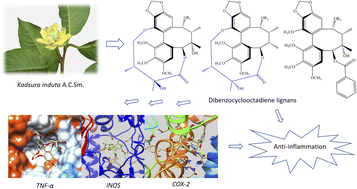New dibenzocyclooctadiene lignans from Kadsura induta with their anti-inflammatory activity†
Abstract
Five new dibenzocyclooctadiene lignans, named kadsuindutains A–E (1–5), and three known ones schizanrin F (6), schizanrin O (7), and schisantherin J (8) were isolated from the stems of Kadsura induta. Their structures were determined by analyses of HR-ESI-MS, NMR, and ECD spectra. Compounds 1–5 contain a 2′,4′-dioxygenated-2′,3′-dimethylbutyryl moiety which is rarely reported for dibenzocyclooctadiene lignans. Molecular docking predicted that compounds 1–8 displayed good binding affinity to the active site of iNOS and TNF-α proteins but unstable binding to the active site of COX-2 protein. Additionally, in vitro experiments showed that compounds 1–8 inhibited NO production in LPS-activated RAW264.7 cells with IC50 values from 10.7 μM to 34.0 μM, compared to the positive control L-NMMA (IC50 = 31.2 μM).



 Please wait while we load your content...
Please wait while we load your content...